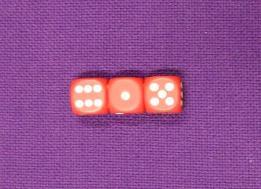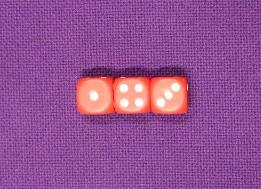Three dice
Investigate the sum of the numbers on the top and bottom faces of a line of three dice. What do you notice?
Problem
Take a look at some ordinary dice.
What do you notice about the way the numbers are arranged?
Now look at these three dice in a row:

Can you use what you found out about the way the numbers are arranged to say what numbers are on the bottom of the dice? Were you correct?
What is the sum of the numbers on the bottoms of the dice?
Let's try that again with three different dice.

Can you work out the total?
Try out some arrangements yourself. Each time record the sum of the numbers on the top and the sum of the numbers on the bottom.
Do you notice a relationship between the 'top sum' and the 'bottom sum'?
Can you explain it?
I experimented with arrangements where the top sum is a multiple of three, and I found that in each case the bottom sum is also a multiple of three. Is it always true?
I try to arrange the dice so that the top and bottom sums are both multiples of four, but can't seem to be able to do it. Can you? Can you explain what you find out?
On the other hand, if I arrange four dice in a row it is easy to make the top and bottom sums both multiples of four. Can you arrange four dice so that the top and bottom sums are both multiples of three? Can you explain what you find out?
Getting Started
It will help to have some dice so you can try out some different arrangements.
How will you remember the totals you have made?
What do you know about opposite faces of a dice?
Student Solutions
Bomere Heath School in England obviously looked at more than just one of this month's problems, here is what Callen, Annalise,Eddi, Alex and Holly said,
We found out that $7+7+7=21$ so every time you roll a dice it will add up to
seven and when you roll three dice it will add up to $21$.
Noah and Guy wrote,
In three dice you roll three dice and add the top score up and the boottem score together and add it together we found out that the answer was always $21$ thats because three times seven makes $21$ and whatever you get on one side add to the other side always make $7$ like $6$ and $1$ and $2$ and $5$ they both make $7$ .
Sian, Mollie and Liam from Deansfield Community School sent in the following;
The opposite sides always add up to $7$. When you have $3$ dice and you take the sum of the top and add the sum of the bottom the total equals $21$. This is because $3\times7$ is $21$.
If there are $4$ dice the sum of the top and bottom will always be $28$ because $4\times7=28$
Thank you all for these interesting findings.
Teachers' Resources
Why do this problem?
Possible approach
You could then introduce the problem with three large dice. Ask children to calculate the sum of the top numbers and the sum of the bottom numbers, and record the results on the board. You could try this a few times altogether, recording the sums each time. Ask the group to try more examples in pairs, then add these findings to the board. Make sure they check their calculations! Gather the group together again and invite learners to comment on anything they notice. Challenge them to explain why the sum of the top and bottom faces added together is always $21$. If they have not realised that opposite faces add to $7$, then you may have to ask a few probing questions about a single dice.
Key questions
Possible extension
Possible support


